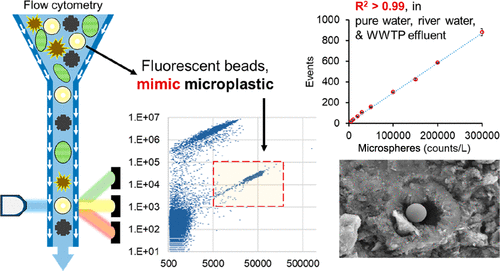当前位置:
X-MOL 学术
›
ACS ES&T Eng.
›
论文详情
Our official English website, www.x-mol.net, welcomes your
feedback! (Note: you will need to create a separate account there.)
Quantitively Analyzing the Variation of Micrometer-Sized Microplastic during Water Treatment with the Flow Cytometry-Fluorescent Beads Method
ACS ES&T Engineering ( IF 7.4 ) Pub Date : 2021-10-06 , DOI: 10.1021/acsestengg.1c00253 Xian-Shi Wang 1 , Heng Song 2 , Yu-Lei Liu 1 , Xiang-Rui Pan 2 , Hao-Chen Zhang 1 , Zhi Gao 1 , De-Zhen Kong 1 , Rui Wang 1 , Lu Wang 1 , Jun Ma 1, 2
ACS ES&T Engineering ( IF 7.4 ) Pub Date : 2021-10-06 , DOI: 10.1021/acsestengg.1c00253 Xian-Shi Wang 1 , Heng Song 2 , Yu-Lei Liu 1 , Xiang-Rui Pan 2 , Hao-Chen Zhang 1 , Zhi Gao 1 , De-Zhen Kong 1 , Rui Wang 1 , Lu Wang 1 , Jun Ma 1, 2
Affiliation

|
Microplastic pollution has aroused surging concerns, while methods for quantitively analyzing the removal of microplastic in water treatment are insufficient. Herein, a flow cytometry (FCM)-fluorescent beads (FB) method was developed for evaluating the removal of micrometer-sized microplastic in water treatment. Commercial fluorescently labeled polystyrene beads (Φ = 3 μm) were spiked into water to mimic microplastic, and FCM was used for quantitive determination. The coefficient of determination (R2) of the amount of spiked microplastics and detected signals in pure water, surface water, and wastewater treatment plant effluent surpassed 0.99. For the removal of microplastics by different coagulants (50 mg/L) at pH 7.0, the removal ratio of microplastics by FeCl3 and polyaluminum chloride was significantly higher than that by polyferric sulfate, alum, Al2(SO4)3, and FeSO4. Over 85% of the polystyrene beads (1.5 × 105 pieces/L) were removed by 50 mg/L of FeCl3 or polyaluminum chloride, and the removal effect was correlated with the size of the floc formed in the hydrolyzation of the coagulants. Filtration was less effective for the removal of microplastics, and the removal efficiency was below 66% when using six kinds of conventional filter materials. Ferrate oxidation was more effective for microplastic removal, as over 93.7% of polystyrene beads (1.5 × 105 pieces/L) were removed by 5 mg/L of ferrate (as Fe) at pH 7.0. The FCM-FB method can be a paradigm for studying the removal of micrometer-sized microplastics in water treatment procedures.
中文翻译:

用流式细胞仪-荧光珠法定量分析水处理过程中微米级微塑料的变化
微塑料污染引起了人们越来越多的关注,而定量分析水处理中微塑料去除的方法不足。在此,开发了一种流式细胞术 (FCM)-荧光珠 (FB) 方法,用于评估水处理中微米级微塑料的去除情况。将商业荧光标记的聚苯乙烯珠 (Φ = 3 μm) 加入水中以模拟微塑料,并使用 FCM 进行定量测定。纯水、地表水和污水处理厂出水中微塑料加标量和检测信号的测定系数(R 2)均超过0.99。对于 pH 7.0 下不同混凝剂 (50 mg/L) 对微塑料的去除,FeCl 3对微塑料的去除率聚合氯化铝显着高于聚合硫酸铁、明矾、Al 2 (SO 4 ) 3和FeSO 4。超过85%的聚苯乙烯珠粒(1.5×10 5 个/L)被50mg/L的FeCl 3或聚合氯化铝去除,去除效果与混凝剂水解形成的絮凝物的大小有关。过滤对微塑料的去除效果较差,使用六种常规过滤材料时去除效率低于66%。高铁酸盐氧化对于去除微塑料更有效,因为超过 93.7% 的聚苯乙烯珠粒 (1.5 × 10 5件/L)被 5 mg/L 高铁酸盐(以 Fe 计)在 pH 7.0 下去除。FCM-FB 方法可以成为研究在水处理过程中去除微米级微塑料的范例。
更新日期:2021-12-10
中文翻译:

用流式细胞仪-荧光珠法定量分析水处理过程中微米级微塑料的变化
微塑料污染引起了人们越来越多的关注,而定量分析水处理中微塑料去除的方法不足。在此,开发了一种流式细胞术 (FCM)-荧光珠 (FB) 方法,用于评估水处理中微米级微塑料的去除情况。将商业荧光标记的聚苯乙烯珠 (Φ = 3 μm) 加入水中以模拟微塑料,并使用 FCM 进行定量测定。纯水、地表水和污水处理厂出水中微塑料加标量和检测信号的测定系数(R 2)均超过0.99。对于 pH 7.0 下不同混凝剂 (50 mg/L) 对微塑料的去除,FeCl 3对微塑料的去除率聚合氯化铝显着高于聚合硫酸铁、明矾、Al 2 (SO 4 ) 3和FeSO 4。超过85%的聚苯乙烯珠粒(1.5×10 5 个/L)被50mg/L的FeCl 3或聚合氯化铝去除,去除效果与混凝剂水解形成的絮凝物的大小有关。过滤对微塑料的去除效果较差,使用六种常规过滤材料时去除效率低于66%。高铁酸盐氧化对于去除微塑料更有效,因为超过 93.7% 的聚苯乙烯珠粒 (1.5 × 10 5件/L)被 5 mg/L 高铁酸盐(以 Fe 计)在 pH 7.0 下去除。FCM-FB 方法可以成为研究在水处理过程中去除微米级微塑料的范例。









































 京公网安备 11010802027423号
京公网安备 11010802027423号